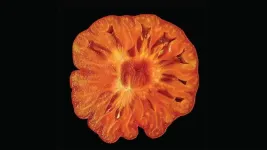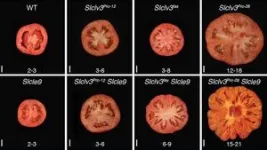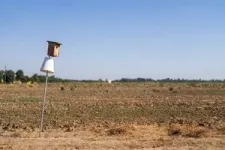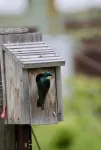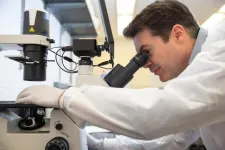(Press-News.org) For tens of thousands of years, evolution shaped tomatoes through natural mutations. Then, humans came along. For centuries, we’ve bred and cherry-picked tomatoes with our preferred traits. Today, CRISPR genome editing allows us to make new crop mutations that improve traits even further. However, individual mutations, whether natural or engineered, don’t work alone. Each operates in a sea of thousands of so-called “background” mutations. These changes have been sowed by evolution and agricultural history. And what if just one could dramatically alter the desired outcome of an engineered mutation?
Now, a plant geneticist and a computational scientist at Cold Spring Harbor Laboratory (CSHL) have teamed up to explore just how predictable plant breeding actually is with natural and CRISPR mutations. To do so, they turned back the evolutionary clock.
CSHL Professor & HHMI Investigator Zachary Lippman and Associate Professor David McCandlish wondered if different natural and engineered mutations could have similar effects on tomato size depending on the presence of two other gene mutations. Using CRISPR, they created a series of mutations in the SlCLV3 gene. (Natural mutation of this gene is known to increase fruit size.) They then combined those mutations with others in genes that work with SlCLV3.
Altogether, they created 46 tomato strains with different combinations of mutations. They found the SlCLV3 mutations produced more predictable effects when certain other mutations were also present. Mutations in one gene produced predictable changes in tomato size, but mutations in another yielded random outcomes. Remarkably, the most beneficial effect involved two mutations that arose millennia ago and were central in tomato domestication.
New research by McCandlish and Lippman may help us better understand genetic predictability. But one thing’s certain. Context matters when introducing new crop mutations. Lippman explains:
“Is genome editing a way to quickly bring in consumer benefits—better flavor, nutrition? The answer is probably yes. The question is how predictable is it going to be.”
Lippman and McCandlish’s work suggests the role of background mutations demands reassessment. “The field will have to grapple with this as we start to make more highly engineered organisms,” says McCandlish. “Once you start making 10, 20 mutations, the probability of having unanticipated results may increase.”
The book of evolution has been written in all different languages, many of which we’re still learning. Plant genetics and computational biology offer two means of deciphering the text. Lippman and McCandlish hope their collaborative interpretation will help science meet the challenge. Looking ahead, it may also help humanity adapt crops to meet the ever-evolving needs of society.
END
You say genome editing, I say natural mutation
2023-10-19
ELSE PRESS RELEASES FROM THIS DATE:
Heat waves harm bird reproduction on agricultural lands
2023-10-19
Bird populations are in rapid decline across North America. While climate change is just one of the many factors influencing North American birds, its effects are significant and can interact with other stressors, such as habitat loss. A team of University of California, Davis, researchers found that the effects of extreme temperatures on avian reproduction can vary depending on the type of environment that birds call home.
The findings, published in the journal Science, shed light on how climate change can combine with habitat loss to affect bird reproduction ...
Astronomers detect most distant fast radio burst to date
2023-10-19
An international team has spotted a remote blast of cosmic radio waves lasting less than a millisecond. This 'fast radio burst' (FRB) is the most distant ever detected. Its source was pinned down by the European Southern Observatory’s (ESO) Very Large Telescope (VLT) in a galaxy so far away that its light took eight billion years to reach us. The FRB is also one of the most energetic ever observed; in a tiny fraction of a second it released the equivalent of our Sun’s total emission over 30 years.
The discovery of the burst, named FRB 20220610A, was made in June last year by the ASKAP radio telescope in Australia ...
Imprinted genes in the ‘parenting hub’ of the brain determine if mice are good parents
2023-10-19
Whether a mouse is a good or bad parent can be traced back to imprinted genes in key neurons in the “parenting hub” in the brain, according to a new study by Anthony Isles of Cardiff University and colleagues, published October 19 in the journal PLOS Genetics.
In mice, there is some evidence that an unusual phenomenon in mammals called genomic imprinting impacts parenting behavior. Mammals inherit two copies of each gene – one from each parent – and usually, each copy is expressed equally in the cell. With imprinted genes, however, only one copy is expressed, ...
With smartphone videos, clinicians can analyze human movement using open source "OpenCap" platform, 25x faster and at a fraction of the cost of labs
2023-10-19
With smartphone videos, clinicians can analyze human movement using open source "OpenCap" platform, 25x faster and at a fraction of the cost of labs.
####
Article URL: https://journals.plos.org/ploscompbiol/article?id=10.1371/journal.pcbi.101XXXX
Article Title: OpenCap: Human movement dynamics from smartphone videos
Author Countries: US
Funding: SDU, AF, LK, JM, ASC, JLH, and SLD were supported by the National Institutes of Health (https://www.nih.gov; grant 1P41EB027060-01A1) and the Wu Tsai Human Performance Alliance (https://humanperformancealliance.org). ASC and MK were supported by Philips Healthcare (https://www.usa.philips.com/healthcare) ...
New smartphone app quickly analyzes human motion to aid physical rehabilitation
2023-10-19
WHAT:
A research team funded by the National Institutes of Health has developed a smart phone app that can track and analyze a person’s ability to move from one place to another, known as locomotion, and other types of movements. Human motion analysis is used to evaluate patients with movement difficulties, to help clinicians plan surgery, and to assess the results of treatment procedures. The research team believes that using the app costs about 1% of conventional motion analysis techniques and works 25 times faster. The study appears in PLOS Computational Biology.
Researchers tested their app, called OpenCap, with 100 participants. Using two or more smart phones, ...
BNP peptide a culprit in eczema
2023-10-19
Researchers from North Carolina State University have pinpointed a particular peptide’s role in activating atopic dermatitis, or eczema. The work could lead to more effective treatments for the condition.
Atopic dermatitis (AD) is a skin condition characterized by itching, irritated and thickened skin at the site of the irritation. The brain natriuretic peptide (BNP) is a peptide, or short chain of amino acids, that is elevated in patients with AD.
“BNP is expressed in sensory neurons, the neurons responsible for conveying sensation to the brain via the spinal cord,” ...
Researchers confirm postpartum depression heritability, home in on treatment mechanism
2023-10-19
CHAPEL HILL, NC – Postpartum depression (PPD), a common subtype of major depressive disorder, is more heritable than other psychiatric conditions, yet the genetics of PPD are understudied compared to these other psychiatric conditions., such as anxiety and bipolar disorder.
To remedy that, UNC School of Medicine researchers led an international team of researchers to conduct the largest-ever meta-analyses of genome-wide association studies (GWAS) to investigate the genetic architecture of PPD.
Published in the American Journal of Psychiatry, their research shows that approximately 14 percent of the variation seen in PPD cases can be attributed to common genetic factors. A patient’s ...
OU-led study documents new extremes in stratospheric water vapor
2023-10-19
A University of Oklahoma-led article published in Geophysical Research Letters highlights newly measured extremes recorded during the National Aeronautics and Space Administration Dynamics and Chemistry of the Summer Stratosphere field project.
“Extreme Altitudes of Stratospheric Hydration by Midlatitude Convection Observed During the DCOTSS Field Campaign,” led by OU School of Meteorology Interim Director and Associate Professor Cameron Homeyer, summarizes the extremes in measured stratospheric depth of hydration by convection recorded during the DCOTSS project as a whole, and ...
Can golden retrievers live longer?
2023-10-19
Golden retrievers are one of the most popular breeds of dogs. But research shows they have up to a 65% chance of dying from cancer. In a new study, University of California, Davis, researchers set out to find if certain genetic factors could help their survival rate. But instead of searching for genes associated with a cancer diagnosis in the breed, they instead chose to look for genes associated with longer life.
The gene they found is in a family of proteins long known to be important in human cancers. Specific versions or variants ...
University of Cincinnati researcher joins pediatric immunotherapy network
2023-10-19
Each year, approximately 200 to 300 children in the United States are diagnosed with diffuse midline gliomas (DMG), a tumor that begins in the brain or spinal cord.
The tumors cannot be removed through surgery due to their location in the brain, and current treatments are not effective and lead to a nearly zero percent survival rate.
The University of Cincinnati’s Timothy Phoenix is part of a multi-investigator collaborative team with St. Jude Children’s Research Hospital’s Stephen Mack, PhD, and Giedre Krenciute, PhD, that received a nearly $4 million National Cancer Institute (NCI) ...
